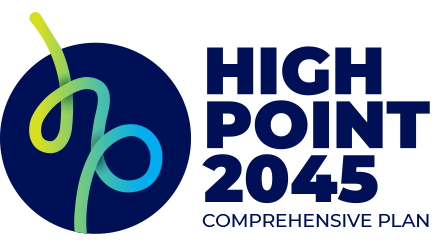OUR GROWTH FRAMEWORK
Urban Design
Urban Design
Urban form is fundamental to the growth framework in High Point.
For High Point to achieve many of its community’s goals, it will require a physical form that is not currently found outside of downtown.
Much of the city exhibits typical auto-centric suburban design where the focus is on moving automobiles. It is difficult to get around without a car. Land uses are separated, and along most corridors, strip commercial centers and other buildings are setback far from the street with parking lots abutting the public realm. Continued growth while making significant progress on High Point’s priorities will not be possible if this pattern continues.
High Point must look, feel, and function like traditional urban space. This requires the thoughtful integration of numerous ingredients, from street design to the placement of parking to the ways that buildings engage the public right-of-way.
For a city to have vibrancy and sense of place, it is crucial that it has great streets
The public realm (streets and other public spaces) and the private realm (buildings and other private space) must seamlessly integrate. The treatment of this “interface” between the public and private realms is a key ingredient in great streets. This is true for both commercial / mixed-use and neighborhood streets, in both a suburban and urban context.
Neighborhood Design
The design of streets and the integration of the public and private realms is as important in neighborhoods as it is in mixed-use areas. Streets with sidewalks accessible to everyone along with street trees, lighting, and landscaping can make a neighborhood feel safe and inviting. When combined with a mix of architectural styles and housing types new neighborhoods can develop a sense of place and authenticity that is often only associated with older established neighborhoods.
High Point is not alone
Cities across the country have committed to developing authentic urban form for new mixed-use centers and corridors. Austin and Columbus are just a couple that have developed new urban neighborhoods and districts with an integrated transportation, land use, and urban design approach. They established goals through planning processes, updated land development regulations, and set high standards. Contrary to common criticism, developers often embrace this approach when combined with a by-right development review process. A by-right process would grant approval for projects that comply with the development standards without a discretionary review process. It brings certainty to the review process and more certainty equals less risk. This not only benefits those who are building things but also cities and their residents by bringing predictability and authenticity to new urban development.







